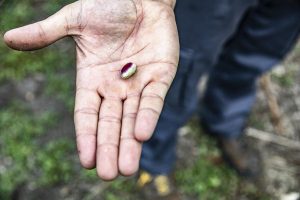Pistachio Origins and Diffusion
The pistachio is native to Asia Minor, a geographical area that today includes Iran, Pakistan, Palestine, Israel and part of Turkey. This plant, known scientifically as Pistacia verahas been cultivated for millennia, thanks to its ability to adapt to arid climates and rocky terrain, characteristics that have facilitated its spread to many other regions of the world.
The Pistachio in Antiquity
Already in the 10th century B.C., in the time of the Assyrians, the pistachio was considered a precious commodity, so much so that it was reserved for only a few people, such as Queen Sheba and her chosen ones. This privilege reserved for the few was due not only to the rarity of the fruit, but also to its nutritional and symbolic properties. In the Bible, it is recounted that in 1802 B.C., the prophet Jacob offered the Pharaoh of Egypt a selection of myrrh, honey, almonds and pistachios, a gesture that demonstrates the high value attributed to this fruit even in ancient times.
The Arrival of Pistachio in Sicily
The history of the pistachio is deeply linked to Sicily, a land that has known how to value this fruit like few others. Although the cultivation of pistachios in Sicily only officially began in the 19th century, the first steps towards their spread date back many centuries earlier. It was in fact the Arabs, who landed on the island in 827, who brought the pistachio tradition with them, starting cultivation in the provinces of Agrigento and Caltanissetta.
But it is in Bronte, a small municipality on the slopes of Mount Etna, that the pistachio found its ideal habitat. Thanks to its special climate and mineral-rich volcanic soil, the Bronte pistachio developed unique characteristics that made it famous worldwide. It is no coincidence that the dialectal terms 'frastuca' and 'frastucara', which indicate the fruit and the plant respectively, derive from Arabic, testifying to the cultural and linguistic influence left by the Arabs in Sicily.
The Global Pistachio Spread
The pistachio has not remained confined to the lands of the Mediterranean and the Middle East. Starting in the 19th century, pistachio cultivation also spread overseas, reaching California in 1873. California, with its Mediterranean climate, proved to be a fertile ground for pistachio cultivation, so much so that today the United States is among the world's leading producers of this fruit.
In addition to California, pistachios have found a home in Australia, New Zealand and New Mexico, where cultivation has been successfully introduced. Despite this global expansion, Italian production, although representing only a small portion (about 1%) of world production, continues to be considered a niche of excellence, with Bronte pistachios enjoying an unparalleled reputation.
Pistachio Varieties and Their Environmental Contribution
There are different varieties of pistachios, each with unique characteristics that make them suitable for specific environments and climatic conditions. In addition to the Pistacia verawhich is the best known and most cultivated variety, there are other species such as the Pistacia terebinthus, the Pistacia atlantica and the Pistacia lentiscus. These varieties are particularly widespread in the Mediterranean basin and Western Asia, regions that are home to most pistachio plants.
One of the most interesting characteristics of the pistachio tree is its ability to adapt to arid and rocky soils. This resilience makes it a valuable ally in attempts to combat desertification, a growing problem in many parts of the world. Indeed, the pistachio plant is able to thrive in conditions where other crops would fail, helping to stabilise the soil and maintain biodiversity.
The Pistacia Germplasm Bank
Precisely because of the crucial role that pistachios can play in the fight against desertification, numerous studies and research have been conducted on this plant. This led to the establishment of a Pistacia germplasm bank, which is now kept at the Jacob Blaustein Institutes for Desert Research in Israel. This bank preserves a wide range of pistachio varieties, contributing to genetic conservation and research for the improvement of future crops.
The Pistachio in Sicilian Culture
The pistachio is more than just a dried fruit for Sicily; it is an integral part of local culture and traditions. In Bronte, the pistachio is affectionately called 'green gold', a nickname that reflects its economic and symbolic value to the community. Every two years, the pistachio harvest takes place in Bronte, an event that involves the entire population and is celebrated with festivals and fairs.
Pistachio is also the main ingredient of many typical Sicilian sweets, such as nougat, frutta martorana and the famous 'pistacchioso', a pistachio-based sweet made with traditional methods handed down from generation to generation. In the past, the elders of Bronte called a typical sweet made with pistachio 'frastucata', a term that testifies to the importance of this fruit in daily life and local traditions.
Nutritional Properties and Benefits of Pistachios
Pistachio is not only a tasty fruit, it is also rich in nutritional properties that make it a healthy and beneficial food. It is an excellent source of protein, healthy fats, fibre, vitamins and minerals that contribute to a balanced diet and a healthy lifestyle.
Rich in Antioxidants
Pistachios are particularly rich in antioxidants, substances that help protect the body's cells from oxidative damage caused by free radicals. This damage is associated with ageing and an increased risk of chronic diseases such as cancer and heart disease. Among the antioxidants found in pistachios, vitamin E is particularly effective in protecting cells and keeping the skin young and healthy.
Supporting Cardiovascular Health
Pistachios contain monounsaturated and polyunsaturated fatty acids, which are beneficial for heart health. These fats help reduce LDL (bad cholesterol) levels in the blood, while increasing HDL (good cholesterol) levels. In addition, pistachios are a good source of arginine, an amino acid that helps relax blood vessels and improve circulation.
Supporting Weight Management
Despite being a high-calorie food, pistachios can be helpful in weight management. Their combination of protein, fibre and healthy fats helps to promote satiety, reducing the desire for unhealthy snacks and helping to control overall calorie intake.
Promoting Eye Health
Pistachios contain lutein and zeaxanthin, two antioxidants that are particularly beneficial for eye health. These compounds help protect the eyes from damage caused by blue light and reduce the risk of developing age-related eye diseases such as macular degeneration.
Source of Essential Minerals
Pistachios are a good source of essential minerals such as magnesium, potassium and phosphorus, which are important for bone health, blood pressure regulation and the proper functioning of muscles and nerves. Magnesium, in particular, is involved in over 300 biochemical reactions in the body, making it an essential mineral for overall health.
The Bronte Pistachio: An Italian Excellence
Although Italy accounts for only a small part of the world's pistachio production, the Bronte pistachio is considered a true excellence. This fruit, grown in a unique area on the slopes of Mount Etna, has organoleptic characteristics that clearly distinguish it from other varieties.
Characteristics of the Bronte Pistachio
The Bronte pistachio is prized for its intense green colour, sweet and aromatic flavour and delicate texture. These characteristics are mainly due to the microclimate of the region and the composition of the volcanic soil, which is particularly rich in minerals. The Bronte pistachio is also smaller than other varieties, but its flavour is more concentrated and complex.
A Protected Product
The Bronte pistachio has been awarded the protected designation of origin (PDO), a recognition that guarantees the authenticity and quality of the product. This mark protects the Bronte pistachio from imitations and counterfeits, ensuring that only pistachios grown in this region can be marketed under the name 'Pistacchio Verde di Bronte DOP'.
The Role of Pistachio in Sicilian Cuisine
The Bronte pistachio is a very versatile ingredient, used in a wide range of sweet and savoury recipes in Sicilian cuisine. Among the most famous desserts are pistachio nougat, Sicilian cassata with pistachios, and pistachio ice cream, a true symbol of the Sicilian confectionery tradition.
In the savoury sphere, pistachios are often used to enrich pasta dishes such as pasta with pistachio pesto, or to add a touch of elegance to meat and fish dishes. Pistachio cream is another delicacy that can be spread on bread or used as an ingredient in fine desserts.
Conclusion
The pistachio is more than just a dried fruit: it is a plant with ancient roots, steeped in history and tradition. From its origins in Asia Minor to its spread all over the world, the pistachio has always had a special place in the cultures that have cultivated and appreciated it. In Sicily, and particularly in Bronte, the pistachio has found an ideal environment, becoming a symbol of excellence and quality.
Today, the Bronte pistachio is known and appreciated worldwide for its unique characteristics, and is used in a wide range of culinary preparations that enhance its flavour and beneficial properties. Thanks to its nutritional richness and health benefits, the pistachio continues to be a precious food, able to enrich not only the table, but also the culture and history of the people who cultivate it.
The history of the pistachio is a journey that spans millennia and continents, a journey that continues to this day, enriched by new discoveries and a growing awareness of its value. Whether enjoyed on its own, in a spreadable cream or as an ingredient in refined dishes, the pistachio remains a fruit of timeless appeal, capable of uniting past and present in a single, delicious morsel.




